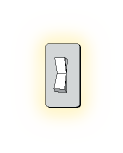Electricity has travelled a long way before it reaches your home.
It has travelled from the power station, through the powerlines to the meter box at your house and then through a series of wires and circuits to the power point in your wall. Here it waits for you to plug in an appliance and turn the switch on.
For the electricity to reach your home it needs to be pushed along the line. This push is given by the voltage. As the electricity travels to your street, it is travelling at levels as high as 220 000 volts then it is stepped down to 240 volts before reaching your meter box.
Your meter box contain circuit breakers or fuses and residual current devices (RCD). 
These devices detect any unsafe levels in electricity and will break the circuit in your home to stop the electricity flowing.
Electricity travels around your home on a circuit.
Often there will be separate circuits for your lights, power points, and large appliances. If one of your appliances happen to be faulty or the power point is overloaded with too many plugs, the fuse or safety switch in your meter box will break the circuit, stopping electrical flow.






